Festival photography plays a crucial role in documenting cultural celebrations and traditions, capturing the essence of community interactions and rituals. It involves techniques that enhance emotional impact, such as candid shots and natural lighting. Preparation is vital for success, including research on the festival’s history and effective communication with organisers. Different cultural influences shape photography styles and present unique challenges that photographers must navigate while preserving authenticity.
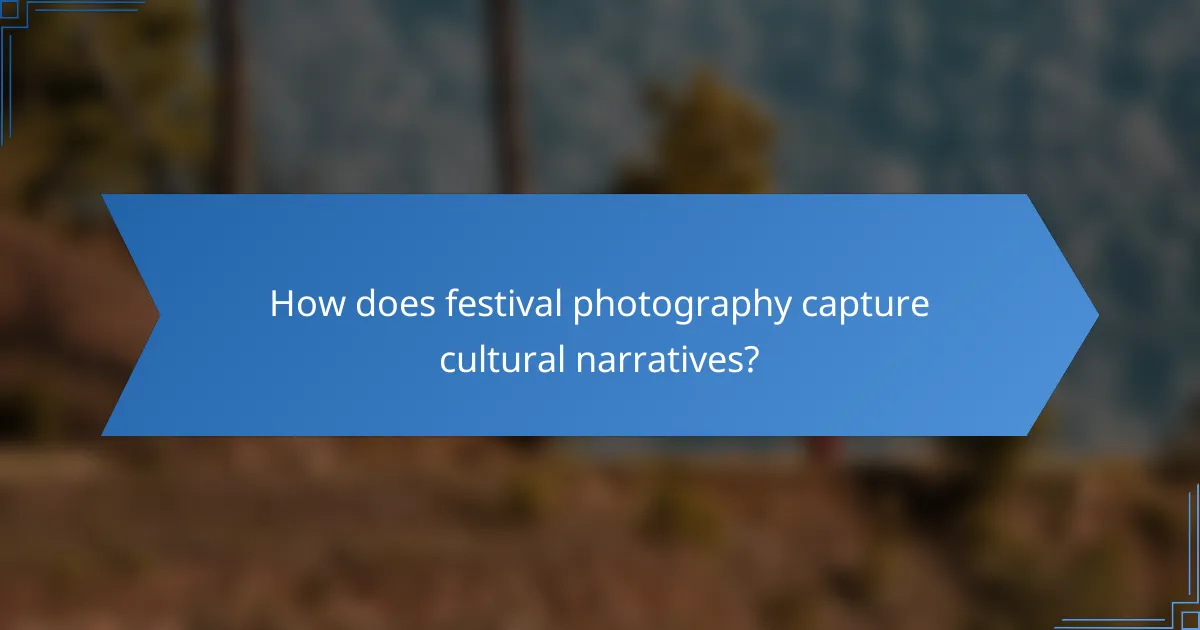
How does festival photography capture cultural narratives?
Festival photography captures cultural narratives by visually documenting traditions, rituals, and community interactions. It showcases the essence of cultural celebrations, highlighting unique attributes such as attire, music, and food. Photographers use their lenses to tell stories, preserving moments that reflect societal values and histories. As a result, these images serve as historical records and foster cultural appreciation among diverse audiences.
What are the key elements of visual storytelling in festivals?
Key elements of visual storytelling in festivals include capturing authentic moments, emphasising cultural symbols, and showcasing community engagement. Effective festival photography highlights emotions, traditions, and the vibrant atmosphere, creating a narrative that resonates with viewers. Unique angles and perspectives can reveal the essence of the celebration, while attention to detail in costumes and decorations adds depth to the story. Additionally, using natural lighting enhances the visual appeal and authenticity of the images.
Why is cultural context important in festival photography?
Cultural context is essential in festival photography as it enhances the authenticity and emotional resonance of images. Understanding the cultural significance of traditions allows photographers to capture moments that convey deeper meanings. This approach fosters respect for diverse practices and highlights unique attributes of various festivals. For instance, recognising local customs can guide photographers in choosing the right angles and subjects, resulting in more compelling narratives. Ultimately, cultural context enriches the storytelling aspect of festival photography, making it a vital component of the craft.
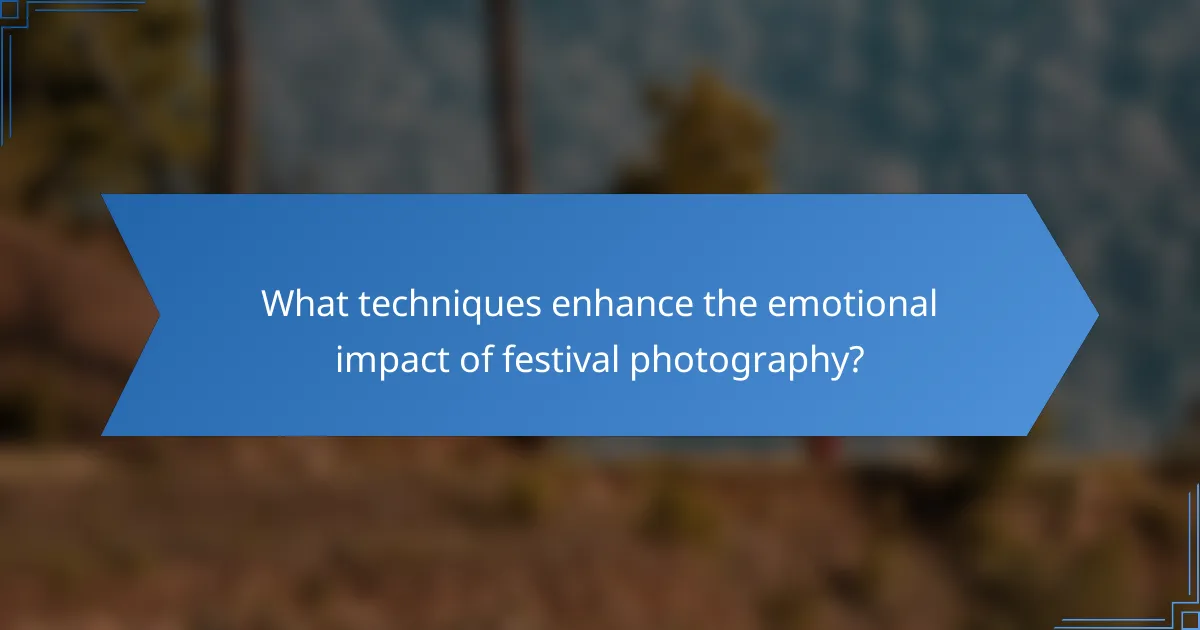
What techniques enhance the emotional impact of festival photography?
Techniques that enhance the emotional impact of festival photography include capturing candid moments, utilising natural lighting, and focusing on expressive subjects. Candid shots create authenticity, revealing genuine emotions. Natural lighting enhances the atmosphere, adding warmth or drama. Focusing on expressive subjects, such as performers or attendees, conveys deeper narratives. Combining these techniques results in powerful visual storytelling that resonates emotionally with viewers.
How can lighting influence the mood of festival images?
Lighting significantly influences the mood of festival images by creating atmosphere and evoking emotions. Different lighting conditions can enhance the vibrancy of colours, highlight cultural elements, and set the overall tone. For instance, warm lighting can create a cosy, inviting feel, while cooler tones may evoke a more serene or somber mood. The time of day also plays a role; golden hour lighting adds a magical quality, enhancing the visual appeal of celebrations. Additionally, the use of artificial lights, such as lanterns or spotlights, can dramatically alter the scene’s dynamics, making images more captivating.
Which composition strategies work best for dynamic festival scenes?
Dynamic festival scenes benefit from a mix of composition strategies that enhance storytelling and capture vibrant energy. Use wide-angle shots to encompass large crowds and convey atmosphere. Close-ups of participants reveal emotions and cultural details. Incorporate leading lines to guide the viewer’s eye and create depth. Experiment with angles; low perspectives can emphasise scale and excitement. Finally, consider timing for candid moments during performances or interactions, ensuring authenticity in your captures.
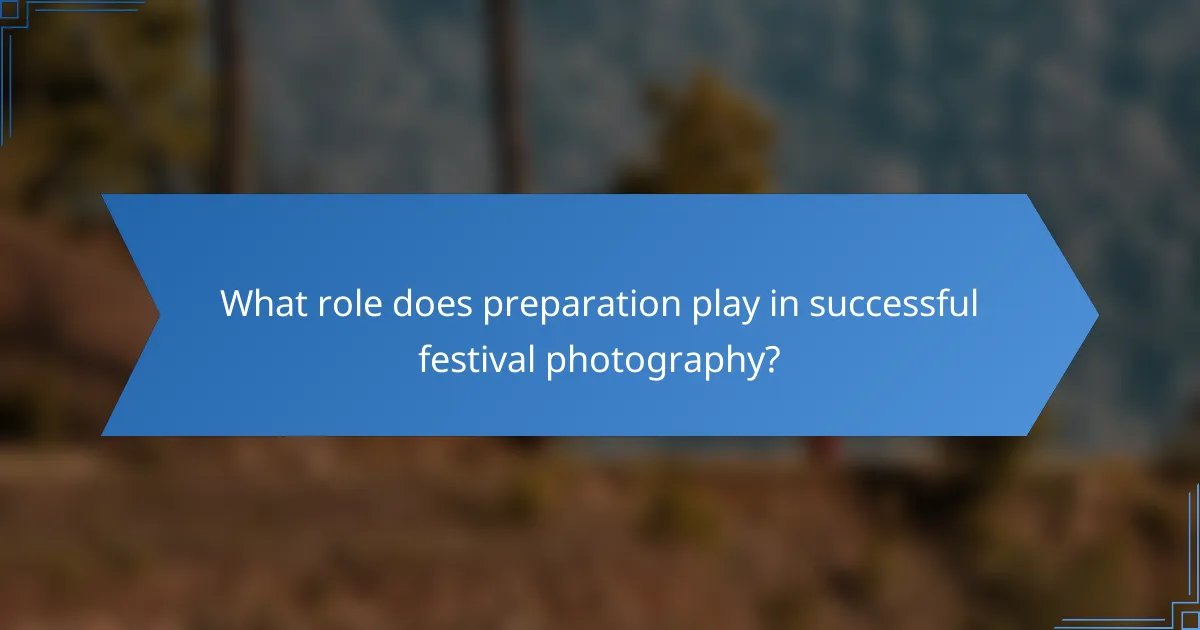
What role does preparation play in successful festival photography?
Preparation is crucial for successful festival photography as it ensures capturing the essence of cultural celebrations. A well-planned approach allows photographers to anticipate key moments, understand the event’s dynamics, and select appropriate equipment.
Researching the festival’s history and traditions enhances storytelling through imagery. Knowing the schedule, locations, and performers helps in positioning for optimal shots. Additionally, preparing gear, such as selecting lenses and ensuring battery life, minimises technical issues during the event.
Effective communication with event organisers can provide insights into unique opportunities. Building rapport with participants can lead to candid moments that reflect the festival’s spirit.
Ultimately, thorough preparation transforms festival photography from mere documentation into a compelling narrative of cultural heritage.
How can photographers effectively plan for diverse festival environments?
Photographers can effectively plan for diverse festival environments by researching the event, understanding cultural nuances, and preparing for varying lighting conditions.
Firstly, they should study the festival’s history and significance to capture authentic moments. Knowing the schedule of events helps in anticipating key moments to photograph.
Next, understanding the cultural context ensures respectful representation of traditions. This includes recognising attire, rituals, and behaviours that are important to the community.
Additionally, photographers must prepare for different lighting conditions. Festivals often occur during various times of day, so having the right equipment and settings ready is crucial for quality images.
Finally, building relationships with local participants can enhance the experience and provide unique opportunities for candid photography.
What equipment is essential for capturing festivals in various conditions?
Essential equipment for capturing festivals includes a DSLR or mirrorless camera, versatile lenses, a tripod, and external lighting. These tools enhance image quality in various conditions. A fast lens is beneficial for low-light situations, while a wide-angle lens captures expansive scenes. A sturdy tripod stabilises shots during longer exposures. External lighting, such as flash or LED panels, ensures proper illumination during nighttime events.
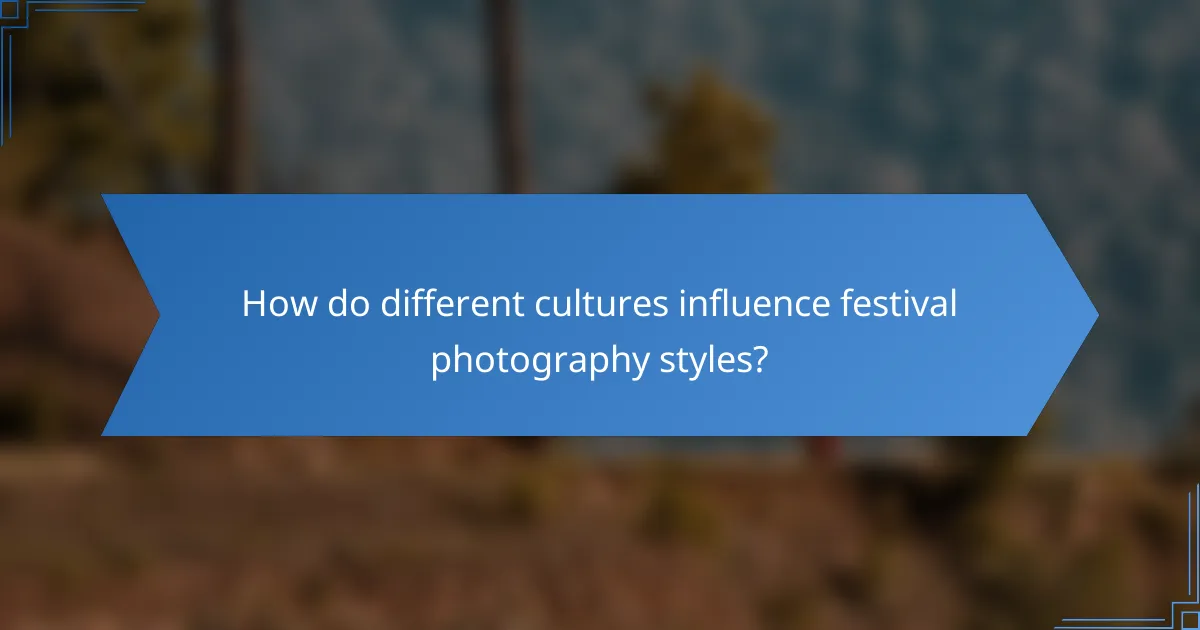
How do different cultures influence festival photography styles?
Different cultures significantly shape festival photography styles through unique traditions, aesthetics, and storytelling techniques. Cultural backgrounds influence the choice of colours, subjects, and compositions. For instance, vibrant festivals in India emphasise bright colours and dynamic movement, while Scandinavian festivals may focus on minimalism and natural landscapes.
Furthermore, cultural narratives inform the themes captured in photography. In some cultures, community participation and rituals dominate the imagery, while others may highlight individual expressions or performances. This diversity in focus creates a rich tapestry of visual storytelling across global festivals.
The use of technology also varies by culture. In regions with advanced technology, photographers may utilise drones and high-resolution cameras, whereas in areas with limited access, traditional methods prevail. These differences in approach reflect the cultural values placed on documentation and artistry.
Ultimately, festival photography serves as a cultural bridge, showcasing the beauty and diversity of global celebrations while preserving unique traditions for future generations.
Which unique attributes define festival photography in specific regions?
Unique attributes defining festival photography in specific regions include cultural significance, traditional attire, local rituals, and distinct landscapes. For example, Indian festival photography often captures vibrant colours and intricate costumes, while European festivals may focus on historical reenactments and architectural backdrops. Each region’s unique traditions influence the visual storytelling in festival photography, showcasing the diversity of cultural celebrations.
What are some rare techniques used in traditional festival photography?
Rare techniques in traditional festival photography include long exposure shots to capture movement, aerial photography for unique perspectives, and infrared photography to highlight contrasts. These methods provide distinct visual narratives that celebrate cultural vibrancy. Additionally, using film cameras can create authentic textures and tones, enhancing the festival’s atmosphere. Employing these rare techniques enriches the storytelling aspect of festival photography, offering deeper insights into cultural traditions.
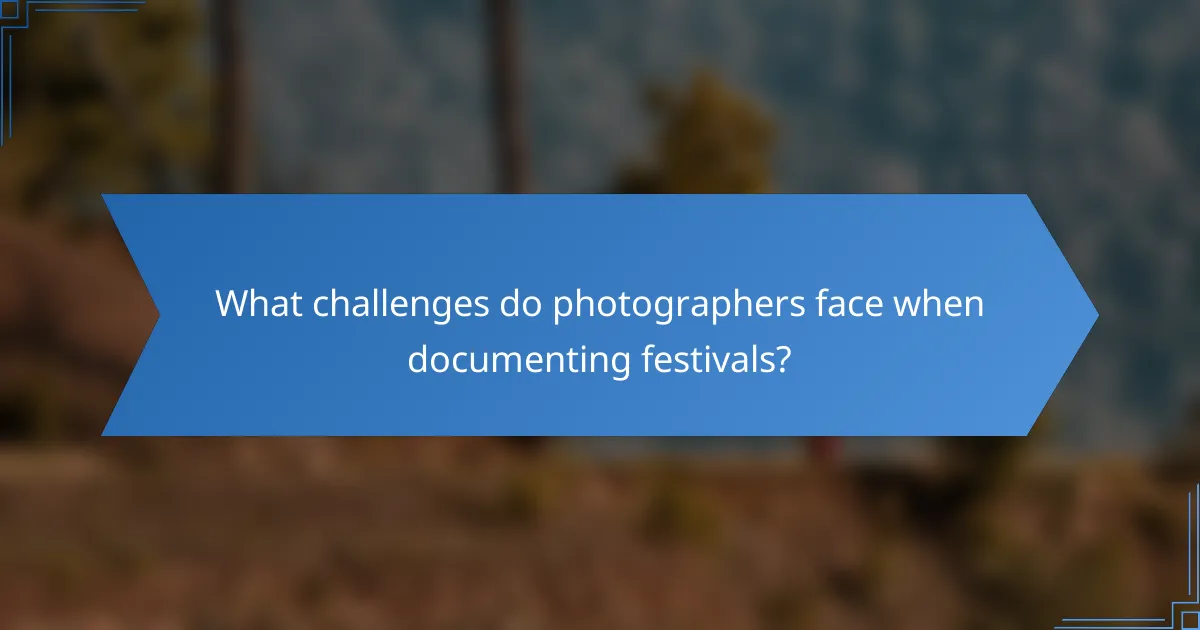
What challenges do photographers face when documenting festivals?
Photographers face various challenges when documenting festivals, including unpredictable weather, large crowds, and limited lighting conditions. They must navigate these obstacles while capturing the essence of cultural celebrations. Time constraints can hinder the ability to capture key moments. Additionally, photographers often deal with cultural sensitivities and permissions, which can vary across different festivals. Balancing artistic vision with practical limitations is essential for successful festival photography.
How can photographers navigate crowd dynamics during events?
Photographers can navigate crowd dynamics during events by employing strategic positioning and anticipating movement. Understanding the flow of attendees helps capture authentic moments while avoiding congestion. Utilising wide-angle lenses enables broader perspectives, enhancing storytelling. Additionally, engaging with participants fosters rapport, leading to more candid shots.
What ethical considerations should be taken into account in festival photography?
Ethical considerations in festival photography include respecting participants’ privacy, obtaining consent, and being culturally sensitive. Photographers should avoid exploiting vulnerable communities and should represent traditions accurately. Additionally, they should consider the impact of their work on the communities they document, ensuring that images are used respectfully and do not misrepresent the festival’s spirit.
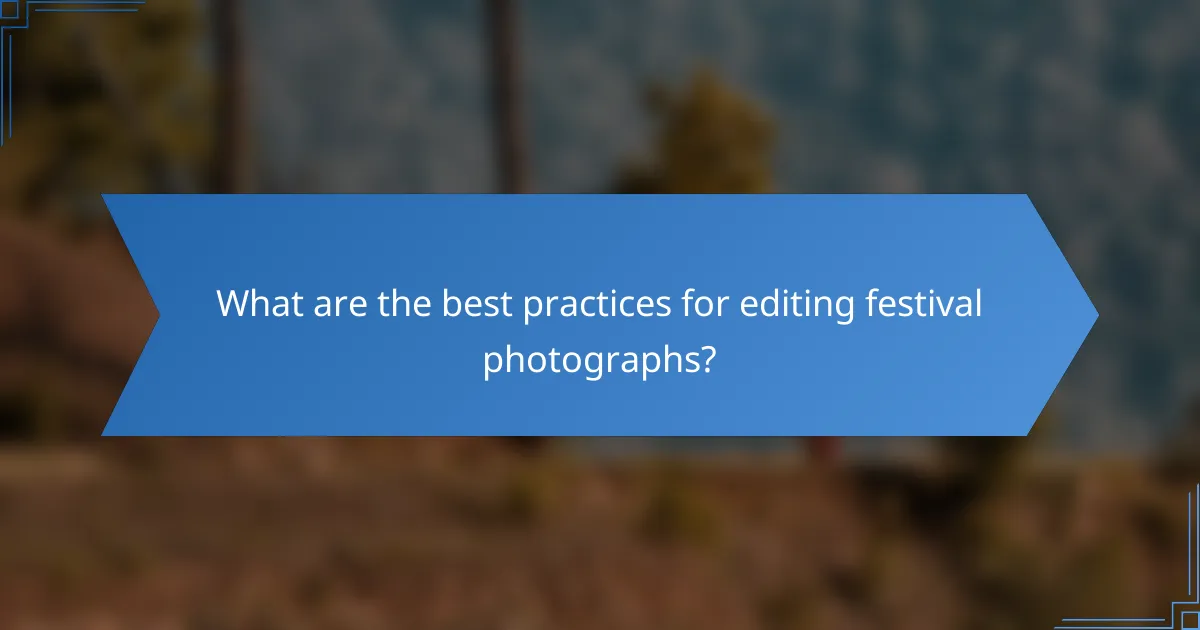
What are the best practices for editing festival photographs?
To edit festival photographs effectively, focus on enhancing the visual storytelling while preserving cultural authenticity. Utilise software tools to adjust exposure, contrast, and colour balance. Crop images to emphasise key subjects and moments, ensuring clarity and engagement. Incorporate consistent editing styles to maintain a cohesive look across the series. Lastly, consider the narrative flow by sequencing images to reflect the festival’s progression.
How can post-processing enhance the storytelling aspect of festival images?
Post-processing enhances the storytelling aspect of festival images by refining visual elements and emphasising cultural narratives. Techniques like colour correction, cropping, and adding effects can create a more immersive experience. For example, enhancing colours can evoke emotions tied to specific traditions, while thoughtful cropping can focus on key moments that capture the spirit of the celebration. Additionally, layering images or creating composites can illustrate the richness of the festival, showcasing various activities and interactions. These enhancements transform simple photographs into compelling visual stories that resonate with viewers.
What common mistakes should photographers avoid when editing festival photos?
Photographers should avoid over-editing, neglecting the event’s atmosphere, and failing to back up original files. These mistakes can diminish the authenticity and quality of festival photos. Over-editing can lead to unnatural images, while neglecting the atmosphere may miss capturing cultural significance. Always maintain original files for potential future edits or prints.
What expert tips can improve festival photography outcomes?
To improve festival photography outcomes, focus on planning, lighting, and composition. Research the festival schedule to capture key moments. Use natural light for vibrant colours and avoid harsh shadows. Experiment with angles and framing to create dynamic shots.